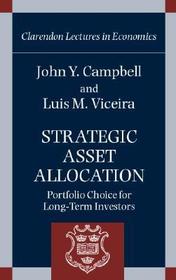
Strategic Asset Allocation
Portfolio Choice for Long-Term Investors
Sorozatcím: Clarendon Lectures in Economics;
-
10% KEDVEZMÉNY?
- A kedvezmény csak az 'Értesítés a kedvenc témákról' hírlevelünk címzettjeinek rendeléseire érvényes.
- Kiadói listaár GBP 83.00
-
39 653 Ft (37 765 Ft + 5% áfa)
Az ár azért becsült, mert a rendelés pillanatában nem lehet pontosan tudni, hogy a beérkezéskor milyen lesz a forint árfolyama az adott termék eredeti devizájához képest. Ha a forint romlana, kissé többet, ha javulna, kissé kevesebbet kell majd fizetnie.
- Kedvezmény(ek) 10% (cc. 3 965 Ft off)
- Kedvezményes ár 35 688 Ft (33 989 Ft + 5% áfa)
Iratkozzon fel most és részesüljön kedvezőbb árainkból!
Feliratkozom
39 653 Ft

Beszerezhetőség
Megrendelésre a kiadó utánnyomja a könyvet. Rendelhető, de a szokásosnál kicsit lassabban érkezik meg.
Why don't you give exact delivery time?
A beszerzés időigényét az eddigi tapasztalatokra alapozva adjuk meg. Azért becsült, mert a terméket külföldről hozzuk be, így a kiadó kiszolgálásának pillanatnyi gyorsaságától is függ. A megadottnál gyorsabb és lassabb szállítás is elképzelhető, de mindent megteszünk, hogy Ön a lehető leghamarabb jusson hozzá a termékhez.
A termék adatai:
- Kiadó OUP Oxford
- Megjelenés dátuma 2002. január 3.
- ISBN 9780198296942
- Kötéstípus Keménykötés
- Terjedelem272 oldal
- Méret 225x146x20 mm
- Súly 469 g
- Nyelv angol
- Illusztrációk 16 figures 0
Kategóriák
Rövid leírás:
This book links cutting-edge academic analysis of portfolio choice to the practical concerns of institutional investors, financial planners, and individual investors. It shows in empirical detail how long-term portfolios should differ from short-term portfolios. It is the first book-length treatment of one of the most exciting areas of modern finance, and is written by a leading academic who is also actively involved in managing a hedge fund.
TöbbHosszú leírás:
Academic finance has had a remarkable impact on many financial services. Yet long-term investors have received curiously little guidance from academic financial economists.
Mean-variance analysis, developed almost fifty years ago, has provided a basic paradigm for portfolio choice. This approach usefully emphasizes the ability of diversification to reduce risk, but it ignores several critically important factors. Most notably, the analysis is static; it assumes that investors care only about risks to wealth one period ahead. However, many investors---both individuals and institutions such as charitable foundations or universities---seek to finance a stream of consumption over a long lifetime. In addition, mean-variance analysis treats financial wealth in isolation from income. Long-term investors typically receive a stream of income and use it, along with financial wealth, to support their consumption.
At the theoretical level, it is well understood that the solution to a long-term portfolio choice problem can be very different from the solution to a short-term problem. Long-term investors care about intertemporal shocks to investment opportunities and labor income as well as shocks to wealth itself, and they may use financial assets to hedge their intertemporal risks. This should be important in practice because there is a great deal of empirical evidence that investment opportunities---both interest rates and risk premia on bonds and stocks---vary through time. Yet this insight has had little influence on investment practice because it is hard to solve for optimal portfolios in intertemporal models.
This book seeks to develop the intertemporal approach into an empirical paradigm that can compete with the standard mean-variance analysis. The book shows that long-term inflation-indexed bonds are the riskless asset for long-term investors, it explains the conditions under which stocks are safer assets for long-term than for short-term investors, and it shows how labor income influences portfolio choice. These results shed new light on the rules of thumb used by financial planners. The book explains recent advances in both analytical and numerical methods, and shows how they can be used to understand the portfolio choice problems of long-term investors.
Finance academics will find a lot to interest them in this book.
Tartalomjegyzék:
Introduction
Myopic Portfolio Choice
Who Should Buy Long-Term Bonds?
Is the Stock Market Safer for Long-Term Investors?
Strategic Asset Allocation in Continuous Time
Human Wealth and Financial Wealth
Investing over the Life Cycle




